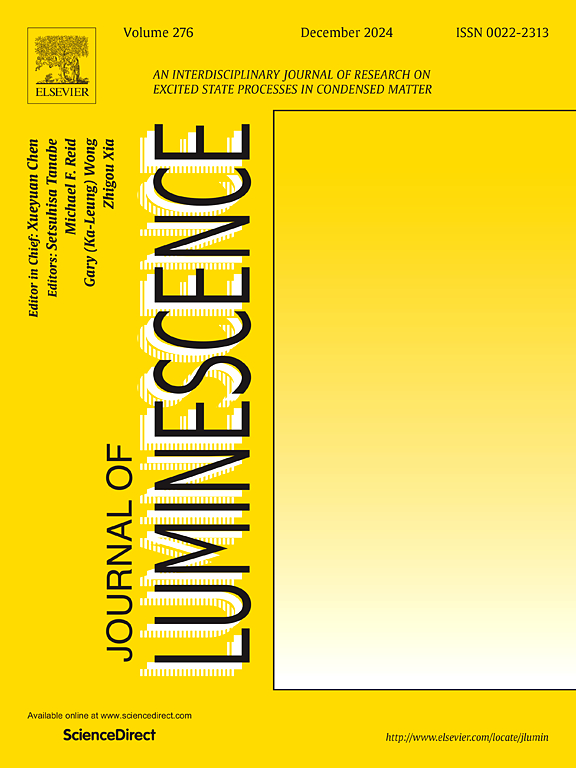Pr3+掺杂RbCaF3:一种新的x射线诱导UVC持久性荧光粉
IF 3.3
3区 物理与天体物理
Q2 OPTICS
引用次数: 0
摘要
持久紫外发光荧光粉在替代癌症治疗中具有广阔的应用前景,其研究进展迅速。在这项工作中,我们开发了一种新型的Pr3+掺杂RbCaF3荧光粉,在220-340 nm范围内表现出强烈的长时间持续发光,在x射线照射15分钟后持续超过1小时。Pr3+离子的5d-4f发光主要由x射线吸收过程中产生的电子-空穴对以及从陷阱中释放的电子激发。利用同步辐射进一步研究了RbCaF3:Pr3+晶体的发射和激发特性,揭示了在4f5d态激发下同时发生构型内4f2→4f2和构型间4f5d→4f2辐射跃迁。这项工作强调了Pr3+掺杂RbCaF3荧光粉在紫外光子学和癌症治疗方面的创新应用潜力。本文章由计算机程序翻译,如有差异,请以英文原文为准。

Pr3+-doped RbCaF3: a new X-ray-induced UVC persistent phosphor
The development of persistent ultraviolet-emitting phosphors is advancing rapidly because of their promising applications in alternative cancer treatments. In this work, we developed a novel Pr3+-doped RbCaF3 phosphor exhibiting intense long-persistent luminescence in the 220–340 nm range, sustained for more than an hour after just 15 min of X-ray irradiation. The 5d-4f luminescence of Pr3+ ions is primarily excited by electron-hole pairs generated during X-ray absorption, as well as by electrons released from traps. The emission and excitation properties of RbCaF3:Pr3+ crystallites were further investigated using synchrotron radiation, revealing the simultaneous occurrence of intra-configurational 4f2→4f2 and inter-configurational 4f5d → 4f2 radiative transitions upon 4f5d state excitation. This work highlights the potential of Pr3+-doped RbCaF3 phosphor for innovative applications in ultraviolet photonics and cancer therapy.
求助全文
通过发布文献求助,成功后即可免费获取论文全文。
去求助
来源期刊

Journal of Luminescence
物理-光学
CiteScore
6.70
自引率
13.90%
发文量
850
审稿时长
3.8 months
期刊介绍:
The purpose of the Journal of Luminescence is to provide a means of communication between scientists in different disciplines who share a common interest in the electronic excited states of molecular, ionic and covalent systems, whether crystalline, amorphous, or liquid.
We invite original papers and reviews on such subjects as: exciton and polariton dynamics, dynamics of localized excited states, energy and charge transport in ordered and disordered systems, radiative and non-radiative recombination, relaxation processes, vibronic interactions in electronic excited states, photochemistry in condensed systems, excited state resonance, double resonance, spin dynamics, selective excitation spectroscopy, hole burning, coherent processes in excited states, (e.g. coherent optical transients, photon echoes, transient gratings), multiphoton processes, optical bistability, photochromism, and new techniques for the study of excited states. This list is not intended to be exhaustive. Papers in the traditional areas of optical spectroscopy (absorption, MCD, luminescence, Raman scattering) are welcome. Papers on applications (phosphors, scintillators, electro- and cathodo-luminescence, radiography, bioimaging, solar energy, energy conversion, etc.) are also welcome if they present results of scientific, rather than only technological interest. However, papers containing purely theoretical results, not related to phenomena in the excited states, as well as papers using luminescence spectroscopy to perform routine analytical chemistry or biochemistry procedures, are outside the scope of the journal. Some exceptions will be possible at the discretion of the editors.
 求助内容:
求助内容: 应助结果提醒方式:
应助结果提醒方式:


